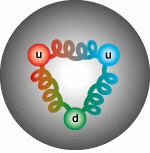
A proton is built up of three quarks. It's the strong force that holds them together.
| F = C * | q1 * q2 r2 |
| F = G * | m1 * m2 r2 |
They represent the strength of the electromagnetic and gravitational interactions respectively, and give us a way of translating the interaction into a measure of force.
C and G give a measure of the strength of an interaction between macroscopic objects, like magnets or planets. In the ghostly quantum world, where interactions between matter particles are carried by force carrying particles, physicists use what they call fundamental coupling constants to describe the strength of an interaction. These coupling constants are very important because they reveal the true, fundamental, nature of the interaction in question. Measuring them can also transport us back to the beginning of time, as we'll see later.
In this project you will measure the strength of the strong force that binds quarks together inside protons, neutrons and all other particles made up of quarks. Like the electromagnetic force, the strong force acts between charges. These, however, are not the familiar electric charges of the electromagnetic force but something else that physicists call colour charge.
Unlike electric charge, which comes in two kinds, positive and negative, colour charge comes in three kinds, which physicists call red, blue and green. Only quarks and the gluons that act between them carry colour charge, that's why quarks are the only matter particles to feel the strong force.
Now, everyone knows that when you get a large build up of electric charges, the sparks start to fly. Think of lightning. So why don't we ever see any colour sparks? The reason is that all the composite particles made up of quarks, like protons and neutrons are colour neutral. They contain either one quark of each colour (add up red, blue and green and you end up with white), or a quark and an antiquark carrying a colour and its anti-colour respectively. That means that concentrations of a single colour just don't exist. Nature's demand that all composite particles be colour neutral is the reason that we never see individual quarks flying out from Z decays, but instead see jets of composite particles.

A proton is built up of three quarks. It's the strong force that holds them together.
The strong interaction is at work each time the Z particle decays into a quark-antiquark pair. However, we never actually see the quarks and antiquarks themselves because nature has been secretive enough to forbid quarks from existing as free, unbound particles. What happens as the quark and the antiquark fly apart is that the strong force between them gets stronger and stronger until eventually new particles are formed as the energy stored in the force condenses into matter. What we eventually see in the particle detector is a spray, or "jet" of particles. Think of the quark and the antiquark flying apart as being like a rubber band stretching more and more. The further the quark and the antiquark move apart, the greater the force between them gets until eventually the rubber band breaks. But when it does you're left with two good rubber bands instead of broken fragments! At LEP the energy is so high that pulling the rubber band results in 20 or so good rubber bands flying all over the place! This is the reason for the jet structure of Z decays into quark-antiquark pairs.
Typically, the quark-antiquark pair gives rise to two back-to-back jets. However, if another gluon is involved it will form a third isolated jet of particles. The event then has a three jet structure. Physicists sometimes call these events "Mercedes" events. The jet coming from the gluon can often be recognized because it is generally less energetic than the others. If yet more gluons are involved the events may have four or even five jets. Since the probability decreases with the number of jets, this gives us a way of working out the value of as. All you have to do is count up the number of three-jet events and divide by the sum of the number of two-jet and four or more jet events. Everything cancels out leaving just as:
| as = | N3-jets N2-jets + N4-jets or more |
Now we are ready to begin the experiment.
Hint: Remember that low energy particles curve more strongly than highly energetic particles in the DELPHI magnetic field. This makes them misleading. Several may curve together to look like a separate jet. Concentrate on the straightest tracks when identifying jets and look at the initial direction of the curved tracks to associate them to a jet.
Here are the ten files of 100 events each to study.
When you are finished you can compare your result with the officially measured value and learn a bit more what this measurement means.